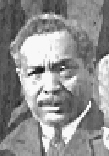William Ashbie Hawkins facts for kids
Quick facts for kids
William Ashbie Hawkins
|
|
|---|---|
 |
|
| Born | August 2, 1862 Lynchburg, Virginia, United States
|
| Died | April 3, 1941 (aged 78) |
| Nationality | American |
| Occupation | Lawyer |
| Known for | African American lawyer, counsel for the Baltimore Branch of the NAACP |
| Relatives | "Red Thunder Cloud" (grandson; born Cromwell Ashbie Hawkins West) |
William Ashbie Hawkins (1862–1941) was one of Baltimore's first African American lawyers. He was born in Lynchburg, Virginia on August 2, 1862. His parents were Reverend Robert and Susan Cobb Hawkins.
Contents
Early Life and Education
William Ashbie Hawkins married Ada M. McMechen in Baltimore on March 14, 1885. They had two daughters, Aldina and Roberta.
He graduated from Centenary Biblical Institute in 1885. This school later became Morgan College. He then started studying law at the University of Maryland School of Law. However, he was asked to leave in 1891 when the school began separating students by race again. He finished his law degree at Howard University in 1892.
Before becoming a lawyer, Hawkins worked as a public school teacher for seven years. On January 29, 1897, he was allowed to practice law in Maryland. He quickly opened his own law office.
Legal Work and Civil Rights
Around 1905, Hawkins teamed up with George W.F. McMechen. George was his wife Ada's brother. They formed the law firm Hawkins and McMechen. Their office moved a few times before settling at 14 E. Pleasant Street around 1920. Their partnership lasted until Hawkins passed away in 1941.
Fighting Segregation on Trains
In 1910, the state of Maryland created the Maryland Public Service Commission. This group had power over companies that transported people or goods. It mainly controlled how much these companies could charge. It also handled complaints about their services.
Soon after, W. Ashbie Hawkins represented people who were upset about segregation. This was due to "Jim Crow" laws. These laws forced Black people to use separate, often worse, facilities. In October 1911, Hawkins took the Baltimore, Chesapeake and Atlantic Railway Company to court. He was angry about the poor sleeping and eating conditions for Black passengers on their ferryboats. His complaint was dismissed, but the Public Service Commission did suggest that the company improve its facilities for Black people in February 1912.
Challenging Housing Segregation
On May 15, 1911, Baltimore's Mayor J. Barry Mahool signed a new city law. This law, called Ordinance No. 610, stopped African Americans from moving into blocks where most people were white. It also stopped white people from moving into blocks where most people were Black.
Hawkins and McMechen were key figures in fighting this segregation law. This law was the first of its kind in the country. Hawkins made his biggest professional impact in 1917. He argued a case called Buchanan v. Warley before the U.S. Supreme Court. He worked as a lawyer for the Baltimore chapter of the NAACP. He also worked with the Afro-American newspapers.
Political Efforts
In 1920, a group of African-American Republicans nominated Hawkins for the United States Senate. However, he was not successful in winning the election.
Later Life and Passing
William Ashbie Hawkins died from heart disease on April 3, 1941. He passed away at Provident Hospital in Baltimore. He had been sick for four years and stayed at the hospital for seven months. He was buried at Mount Auburn Cemetery.

